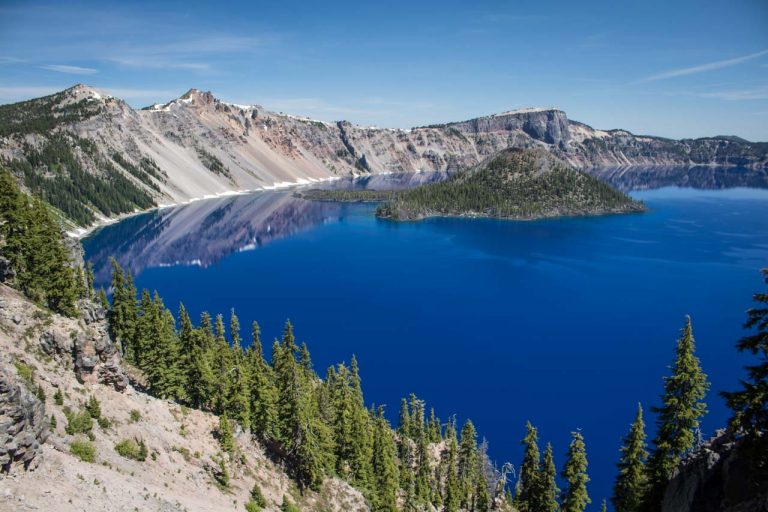12 Top Things to Do in Redwood National & State Parks
Home to the tallest trees on Earth, many of which soar more than 350 feet above the forest floor below, the Redwood National and State Parks are unique in the world.

12 Best Things to Do in Redwood National Park & State Parks, California
Jointly managed by California State Parks and the National Park Service, this four-park complex preserves some of the last remaining groves of coast redwoods (Sequoia sempervirens). This is both an International Biosphere Reserve and a UNESCO World Heritage Site.
When you visit Redwood National Park and its three adjacent state parks, you can walk underneath these enormous trees—some are several centuries old, while the oldest ones have been around since the fall of the Roman Empire.
In addition to walking in an ancient forest of giant trees, other things to do in Redwood National Park and State Parks include beach camping, elk viewing and scenic drives.
Below, you’ll find the top activities and attractions in Redwood National Park, as well as some suggested redwood itineraries and where to stay.
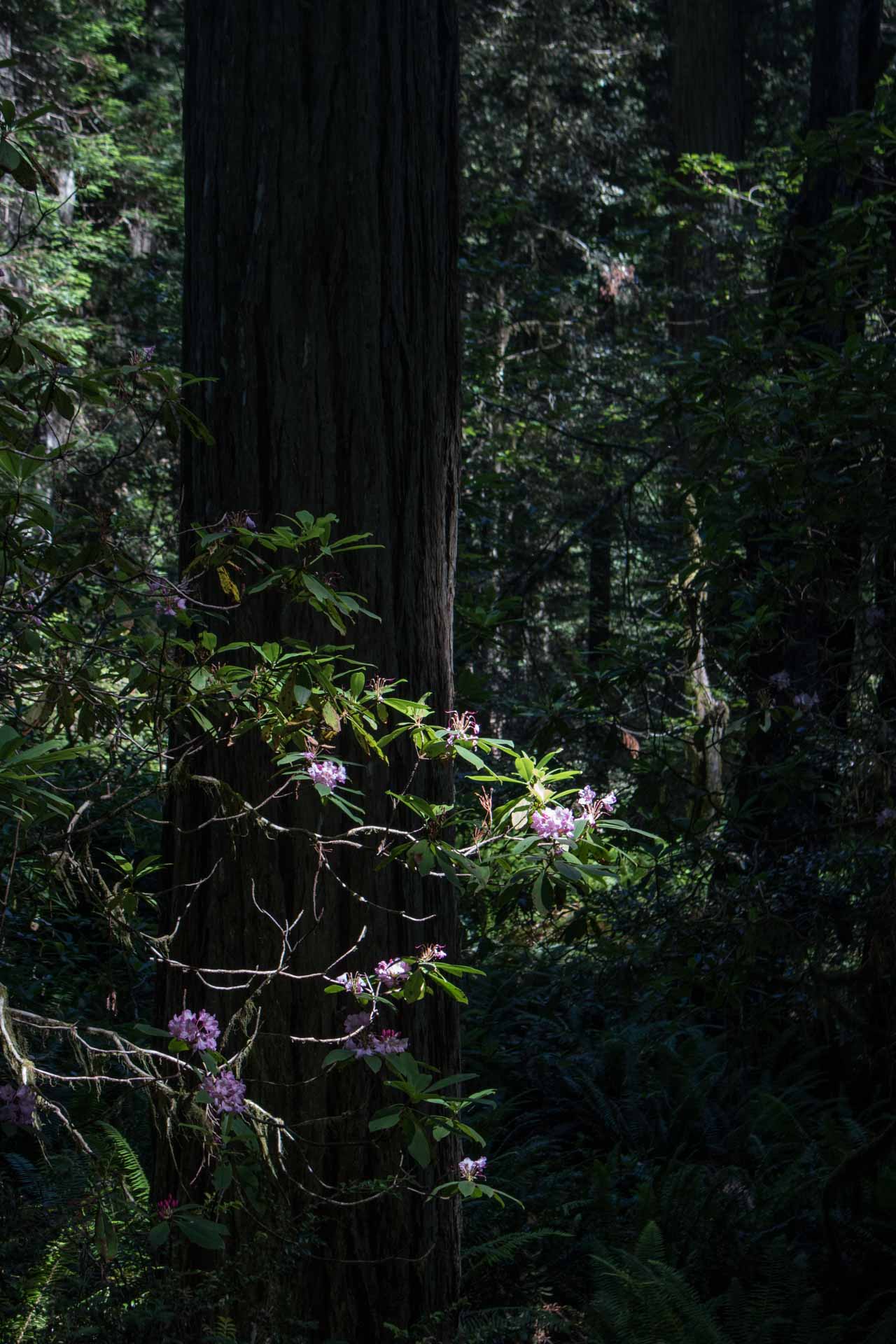
This post about the best things to do in Redwood National Park and State Parks contains affiliate links. You can read more about our Terms of Use / Disclosure here.
What to Do in Redwood National Park & State Parks?
While the massive redwoods are the undisputed highlight of this amazing parks complex in Northern California, I also highly recommend exploring the area’s other, different areas.
There are prairies frequented by herds of Roosevelt elk and the occasional black bear; there’s a fascinating coastline where cliffs and rocks alternate with sandy beaches.
The following list of best things to do in Redwood National and State Park shows the parks’ top activities, ranked from north to south. When driving south on U.S. Route 101—say, on a long road trip from Portland, Oregon—you’ll visit the four parks in this order:
- Jedediah Smith Redwoods State Park
- Del Norte Coast Redwoods State Park
- Prairie Creek Redwoods State Park
- Redwood National Park
When driving north from, for example, San Francisco, simply reverse the order of these Redwood attractions.
1. Explore Stout Memorial Grove
Location: Jedediah Smith Redwoods State Park
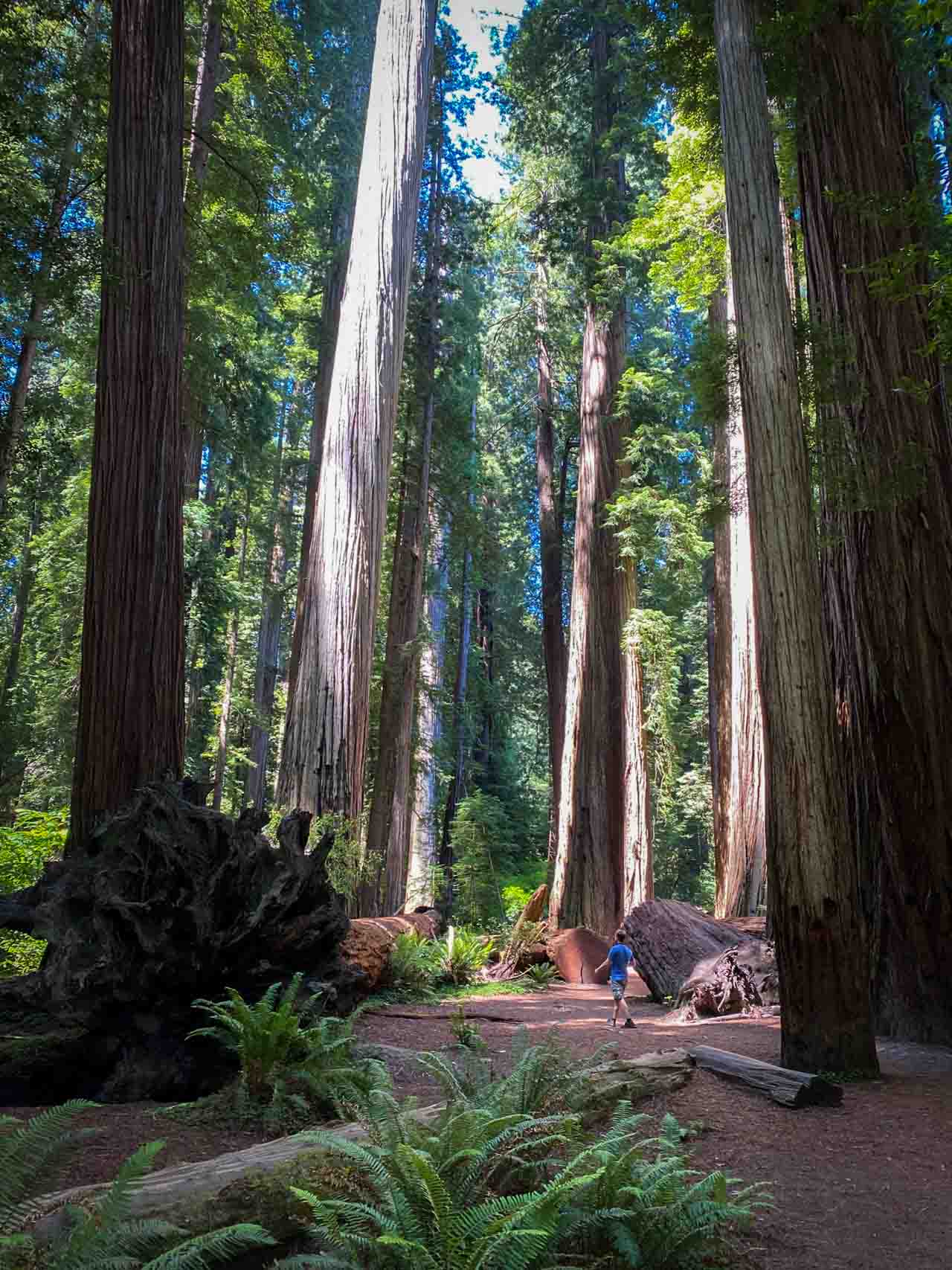
When coming from Oregon and driving south on U.S. 101, Jedediah Smith Redwoods State Park is the first park you’ll get to. And the Stout Memorial Grove Trail is the perfect introduction to the mighty redwoods.
This 44-acre stand of colossal 300-foot old-growth redwoods is the heart of this popular state park, and one of the top attractions in the Redwood National Park and State Parks.
Set on the south bank of the Smith River—which is a popular place for picnicking, swimming and (whitewater) kayaking—the Stout Memorial Grove can be explored on a fun little loop trail.
Due to seasonal floods, the growth of understory trees, bushes and plants is inhibited. This allows you to see, admire and appreciate the full size of these sylvan giants.
There are two ways to access the loop trail: year round from the small parking area at the east end of Howland Hill Road, or in summer across the hiker’s footbridge over the Smith River from the state park’s campground.
2. Hike Down to the Coast on the Damnation Creek Trail
Location: Del Norte Coast Redwoods State Park
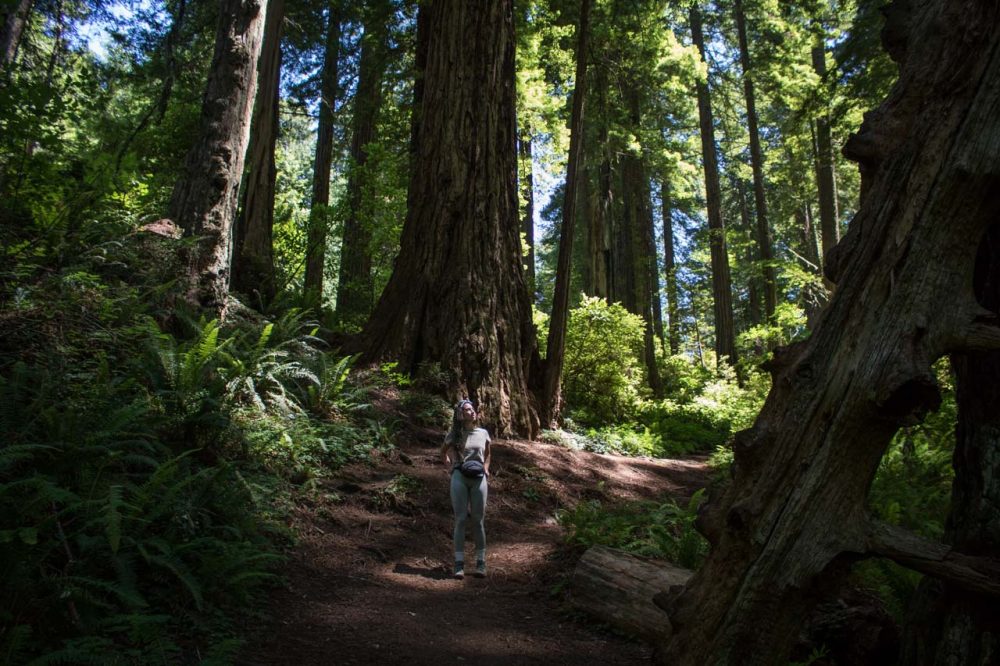
Without question one of the best day hikes in Redwood National and State Parks, the Damnation Creek Trail run down from U.S. 101 to the rugged Northern California coast.
The trailhead is at a small pullout on U.S. 101 in Del Norte Coast Redwoods State Park. Note that you can only pull out here when driving in the southbound lane. When driving north, you have to drive past it, turn around and pull out on the way back.
Unlike many of the shorter Redwood trails, which typically loop around a redwood grove, this longer day hike takes you through a magnificent old-growth redwood forest, down to the Pacific coast.
It’s one of my personal favorite (longer) day hikes in the Redwood parks complex.
The trail runs 1,100 feet down a westward-facing slope, which makes it ideal for a late-afternoon hike—later in the day, the sun lights up the forest beautifully.
I like this trail so much because it offers the chance to experience two of the parks’ major features: the giant redwood forest and the wild rocky coast.
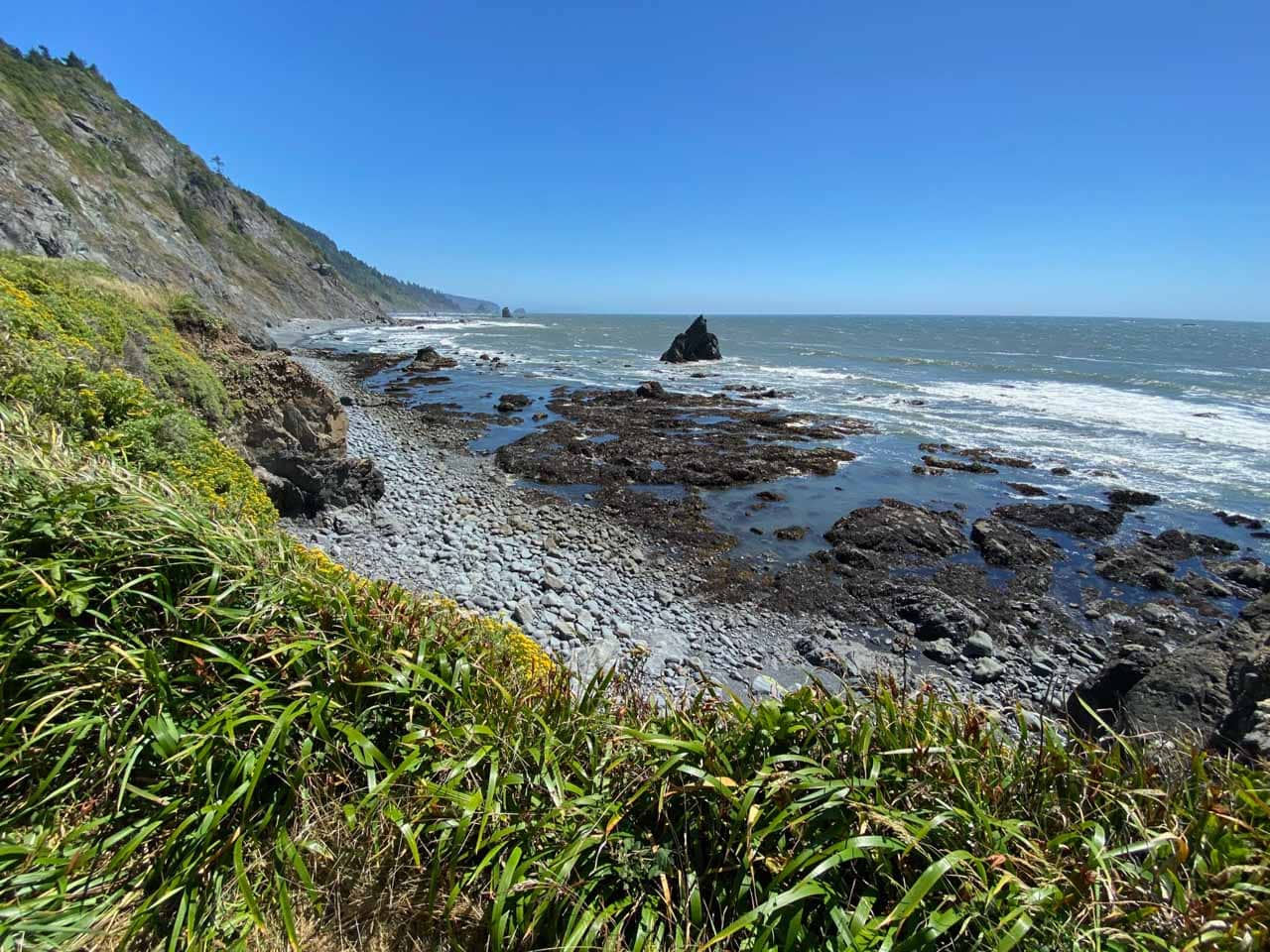
Note that, in this case, the first part of the hike is the easy part. The challenge awaits on the steep 1,100-foot ascent back up from the coast.
Additionally, thanks to its location, it’s also a great place to stop and do a hike on the way between Jedediah Smith Redwoods State Park in the north and Prairie Creek Redwoods State Park / Redwood National Park in the south.
3. Drive the Newton B. Drury Scenic Parkway
Location: Prairie Creek Redwoods State Park
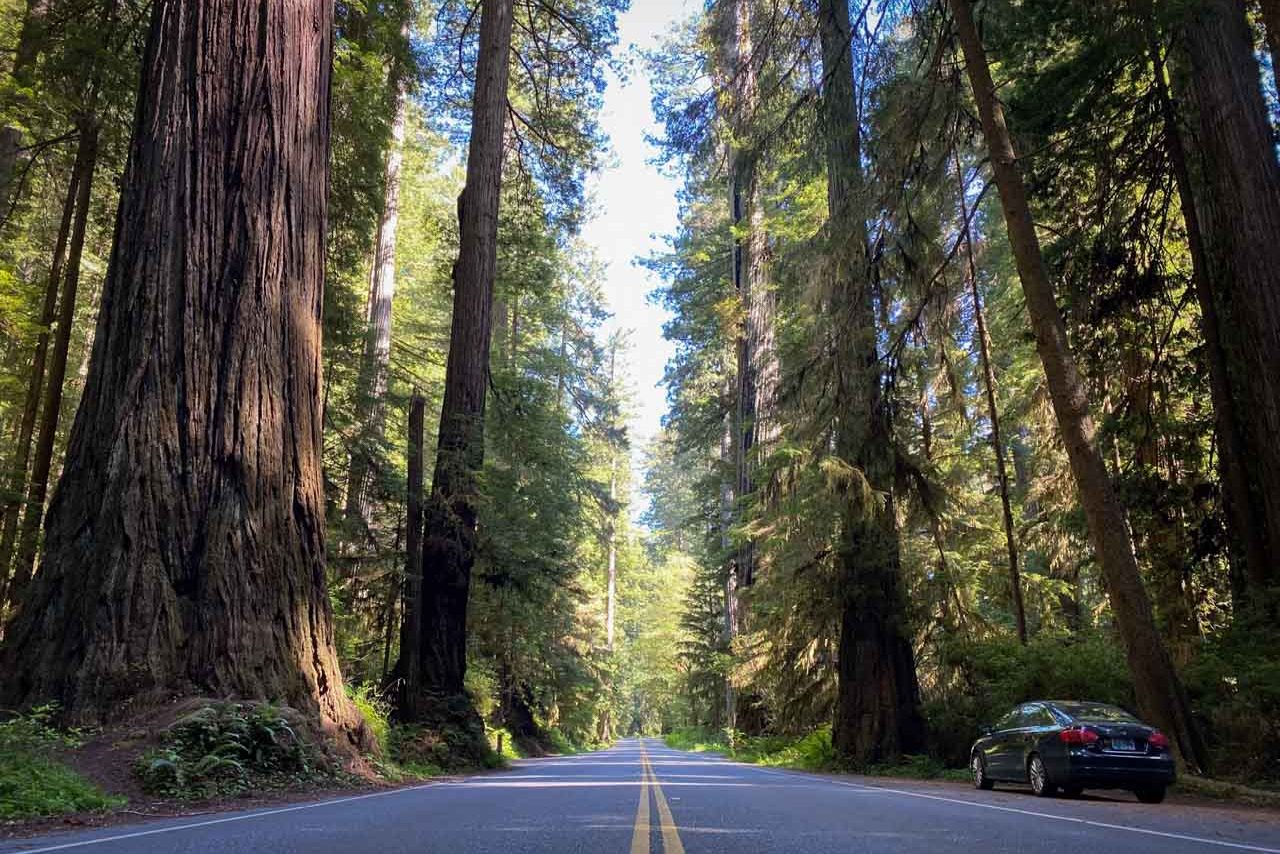
About 10 miles long, the Newton B. Drury Scenic Parkway is a beautiful alternative to U.S. Highway 101 in Prairie Creek Redwoods State Park. It’s a glorious road that takes you through a towering old-growth redwood forest.
If you only have time to do one or two things and you’re wondering where to go in Redwood National Park and State Parks, this should be at the top of your list. It’s a spectacular road.
What makes it so special is that it’s one of just a couple of roads in the world where you can experience the redwoods with any kind of vehicle. From bicycles and motorbikes to huge RVS, all wheeled vehicles can use this scenic redwood road.
There are numerous pullouts and trails for those who’d like to see these giant trees from up close. Popular stops are Big Tree and Elk Prairie, which is home to a large herd of Roosevelt elk.
4. See Roosevelt Elk at Elk Prairie
Location: Prairie Creek Redwoods State Park
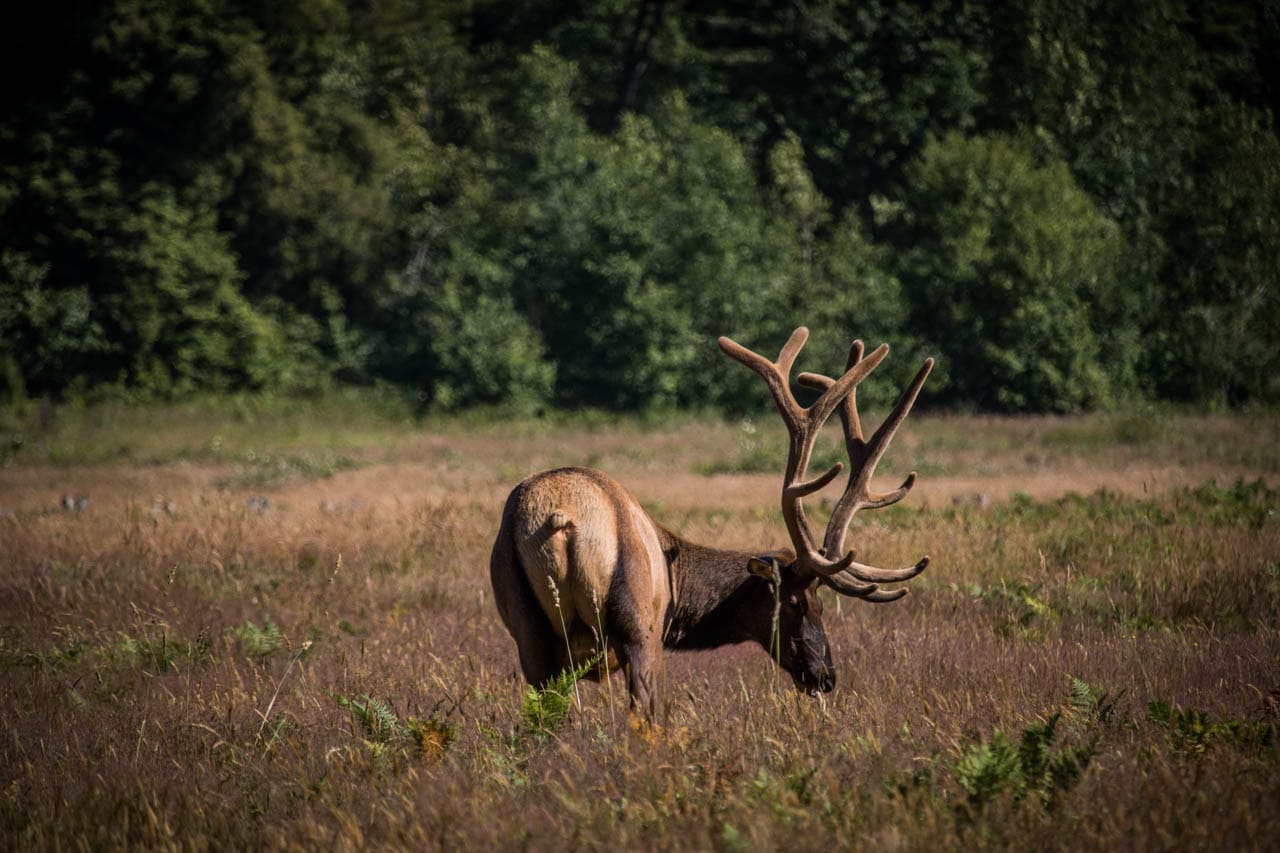
The largest subspecies of elk in North America, the majestic Roosevelt elk can be seen all throughout the Redwood parks system.
The best places to see elk, however, are south of Klamath. Particularly great locations are Gold Bluffs Beach, along the Bald Hills Road, around the town of Orick and, especially, at appropriately named Elk Prairie.
When we arrived at the Prairie Creek Visitor Center, two huge bull elk were peacefully grazing in the prairie just across the road. Later on, we saw a large herd of Roosevelt elk just up the road.
Note: Roosevelt elk are among the largest land mammals in America. Remember that they’re wild animals and, therefore, can be dangerous. Observe them from a safe distance; never approach them. Use a good pair of binoculars and/or a telephoto lens. Be especially careful during calving season (May and June) and mating season (fall).
5. Experience the Redwoods With All Your Senses on the Revelation Trail
Location: Prairie Creek Redwoods State Park
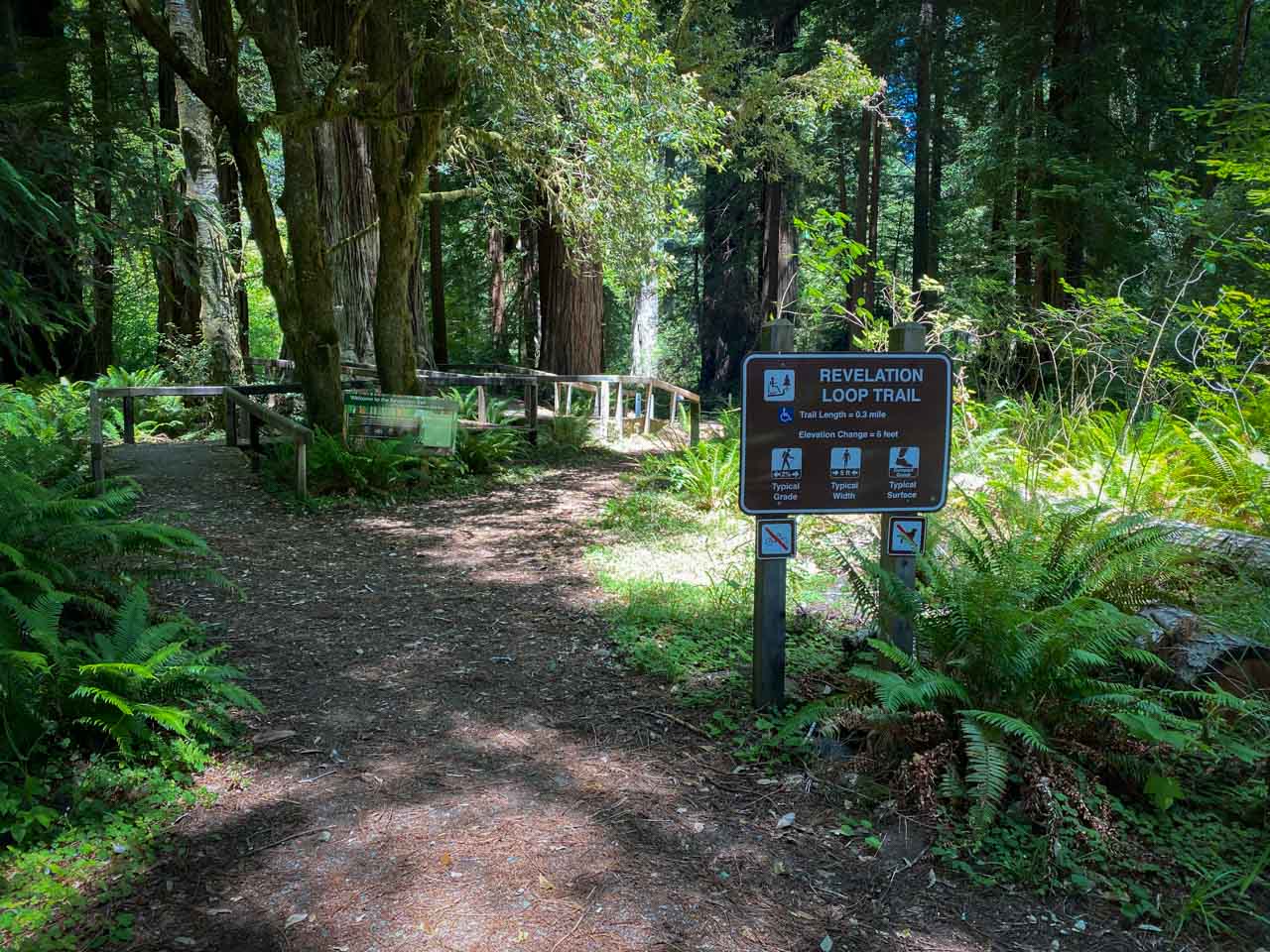
Designed specifically for people who are visually impaired, the Revelation Trail is one of the most extraordinary and immersive hikes in the redwoods. Although only 0.3 miles long, it’s one of the top things to do at Redwood National Park and State Parks.
When walking on this forest path, you are encouraged to use and engage all your senses.
In order to experience the redwood forest to the fullest, you “can touch the rough bark of a redwood and then compare it to the soft feel of a moss-covered fir or spruce, while sounds of the creek murmur in the background. The sharp aroma of California bay and tart taste of redwood sorrel allow for a more complete understanding of the ecosystem.”
6. Camp at Gold Bluffs Beach
Location: Prairie Creek Redwoods State Park
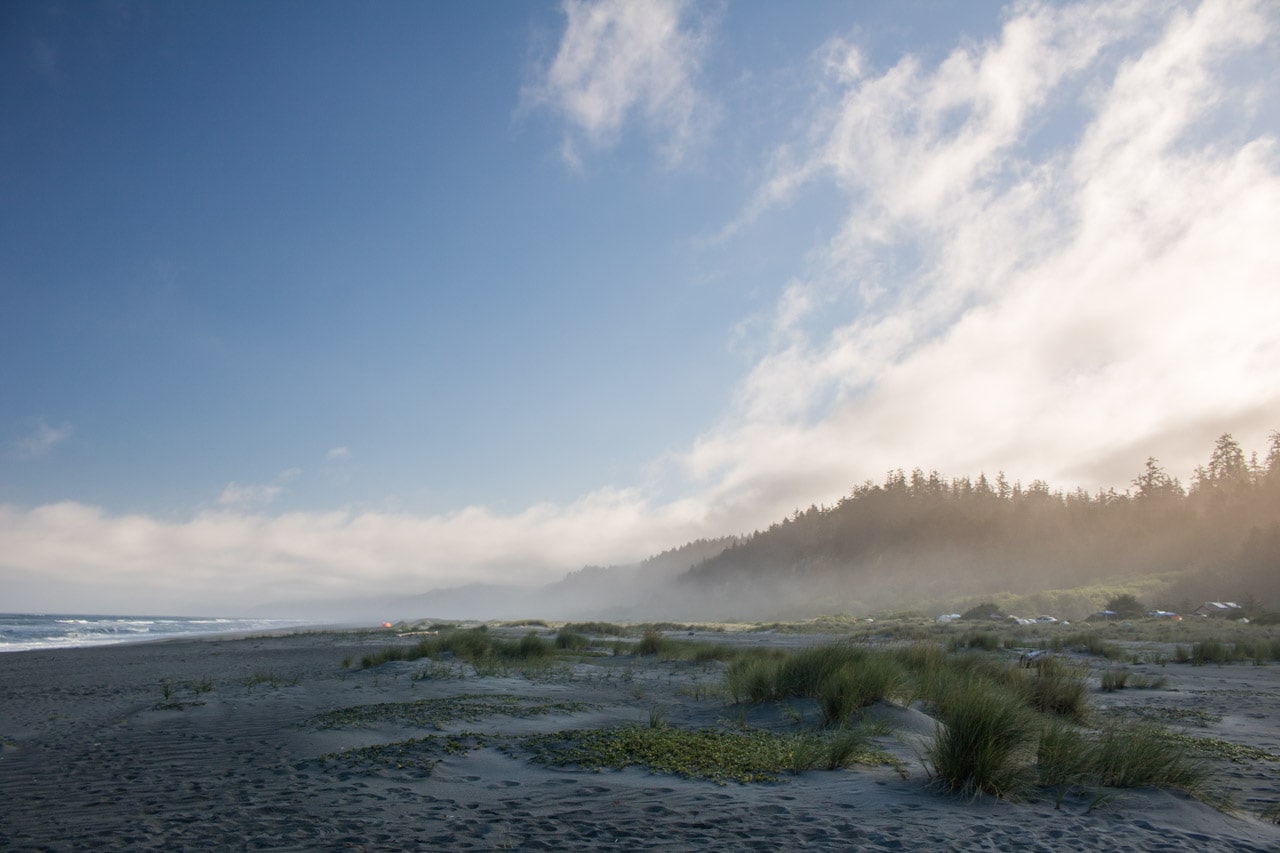
A remote campground in the dunes of Gold Bluffs Beach, this is easily one of the best beach campgrounds in the national parks. It’s located about 6 miles up unpaved Davison Road and offers visitors the chance to camp on the wild Pacific coast and amid Roosevelt elk.
The secluded sandy beach is literally a minute from the campsites, while redwoods top tall cliffs in the background.
From this campground, you can also walk to gorgeous Fern Canyon and access the awesome Miner’s Ridge Trail. The Coastal Trail runs right through the campground as well.
This is a small campground, though, with only 26 sites. You’ll need to book your site well in advance.
As far as facilities go, there are solar showers and flush toilets, barbecues and fire pits, picnic tables and food lockers—more than enough for a remote camping adventure with some basic luxuries.
Note that the first part of Davison Road is very steep and winding. Large RVs and trailers of any kind are prohibited on this road and, as such, at the Gold Bluffs Beach Campground. There are no hookups.
7. Walk Through Prehistoric Fern Canyon
Location: Prairie Creek Redwoods State Park
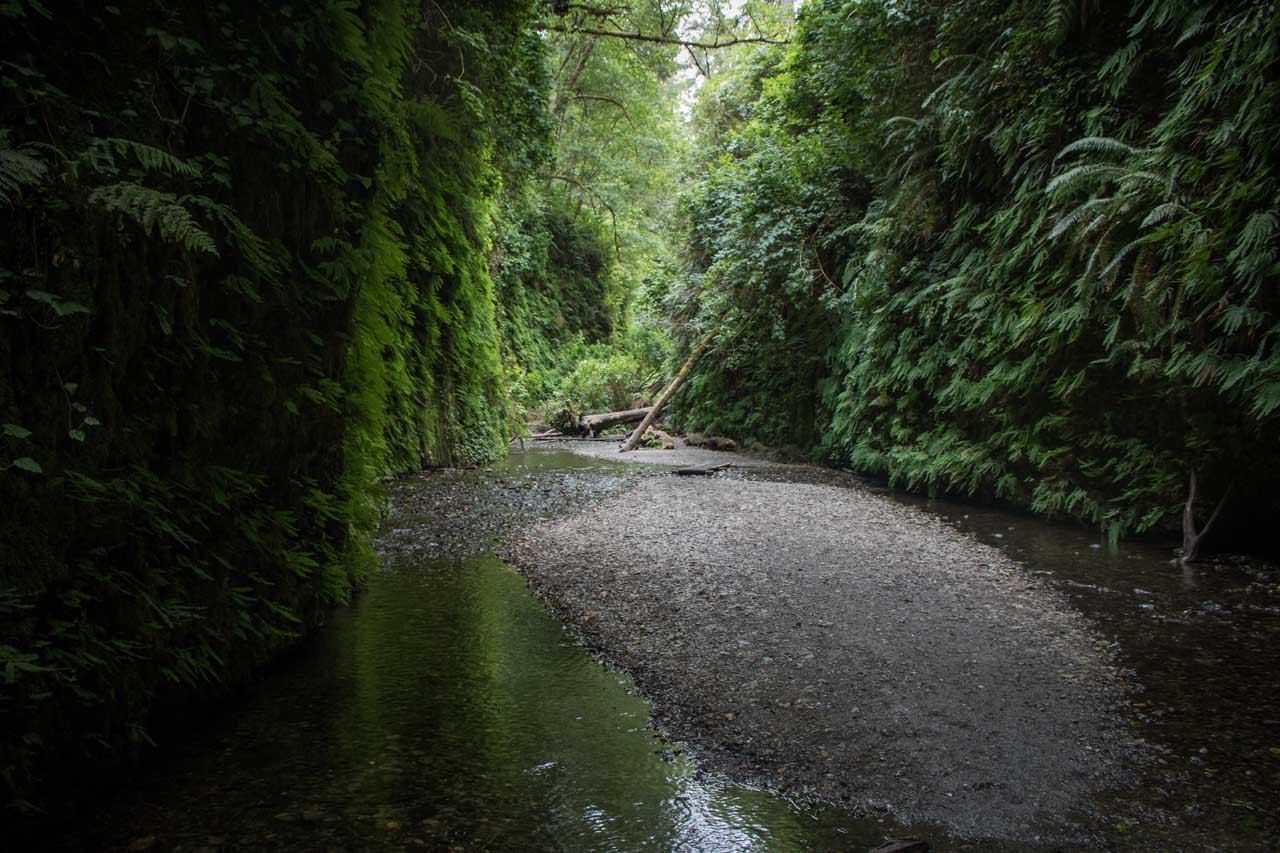
Although you won’t find any towering redwoods here, Fern Canyon is still one of the places you simply must see in Redwood National and State Parks. Flanked by 50-foot-high walls, this mini-canyon is covered in verdant and ancient ferns.
Due to its prehistory appearance, Fern Canyon has served as filming location for scenes in The Lost World: Jurassic Park and the BBC’s Walking With Dinosaurs series.
The Fern Canyon Trail runs through this breathtaking canyon, along and across bubbling Home Creek. You can explore the canyon on a 0.5-mile out-and-back hike or a slightly longer 1-mile loop hike. Prepare to climb through log jams created by winter floods and to get your feet wet!
Exploring Fern Canyon is one of the most popular things to do in the Redwood parks complex. I recommend arriving early to get a parking spot—or alternatively, camp at nearby Gold Bluffs Beach.
8. Go for a Full-Day Hike on the Miner’s Ridge – James Irvine Loop
Location: Prairie Creek Redwoods State Park
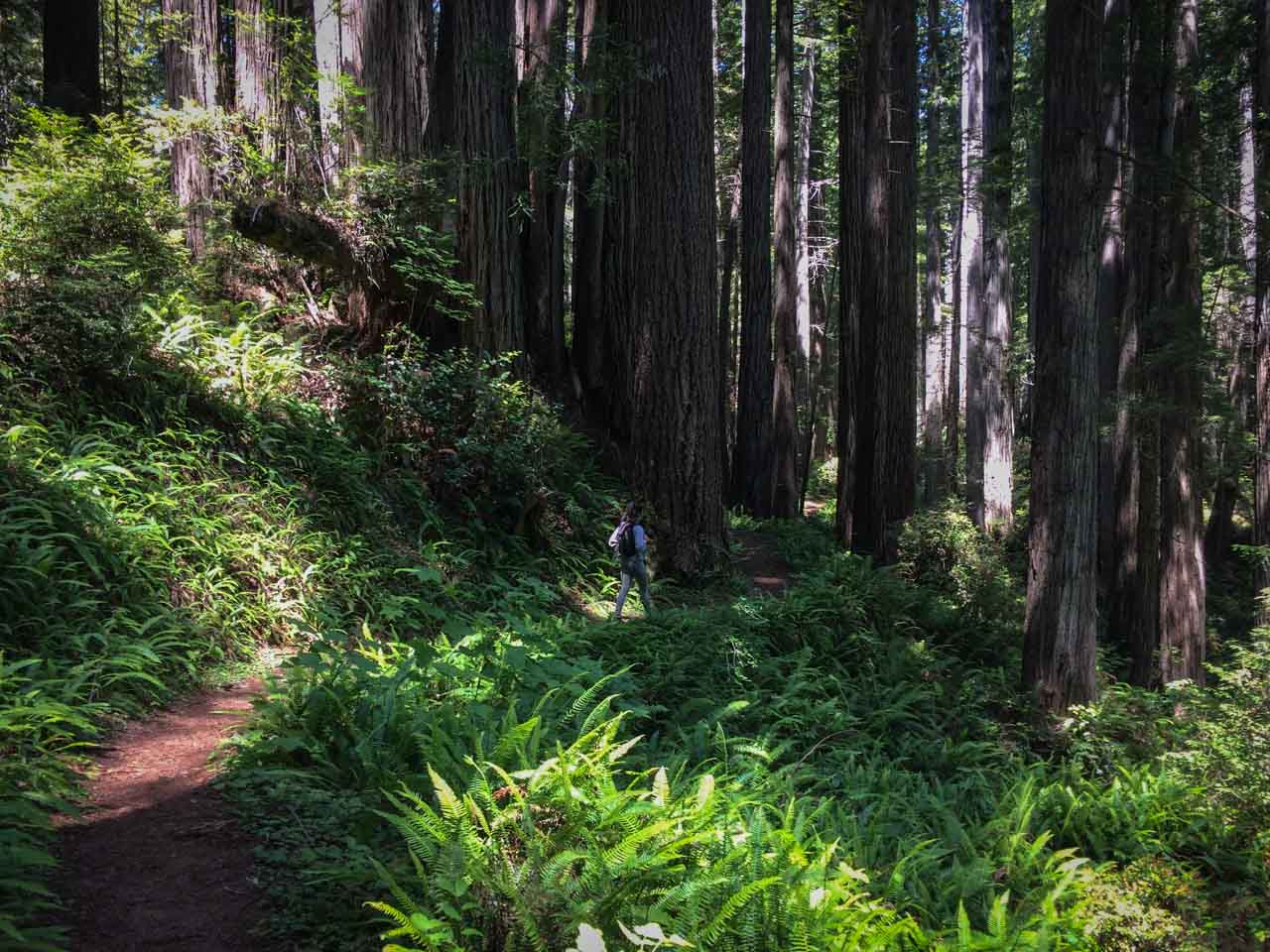
Although hiking the Miner’s Ridge Trail, James Irvine Trail and Fern Canyon Trail loop is a full-day commitment, it’s 100% worth it. In fact, on this 12-mile loop, you get to experience the absolute best of Redwood National Park and State Parks, in all their diversity and beauty.
Calling this the greatest long day hike in the redwoods is not an exaggeration at all. It offers an extraordinary opportunity to enjoy Redwood’s sheer variety of scenery, all on one long hike.
You’ll hike from Elk Prairie through a spectacular old-growth redwood forest, wander through famous Fern Canyon, and also include a section of the Coastal Trail on Gold Bluffs Beach.
Many hikers start this loop at the top, at the Prairie Creek Visitor Center, hiking down to the coast on the James Irvine Trail and back up on the Miner’s Ridge Trail.
However, if you managed to get a site at the Gold Bluffs Beach Campground—easily one of the best national park campgrounds we’ve ever stayed at—you can conveniently start your hike there, too.
From prairie and forest to beach and canyon, this fantastic loop hike is without question one of the best Redwood National and State Parks activities.
Read more: Best Hikes in Redwood National and State Parks
9. Hike a Section of the Coastal Trail
Location: Prairie Creek Redwoods State Park (or Del Norte Coast Redwoods State Park or Redwood National Park)
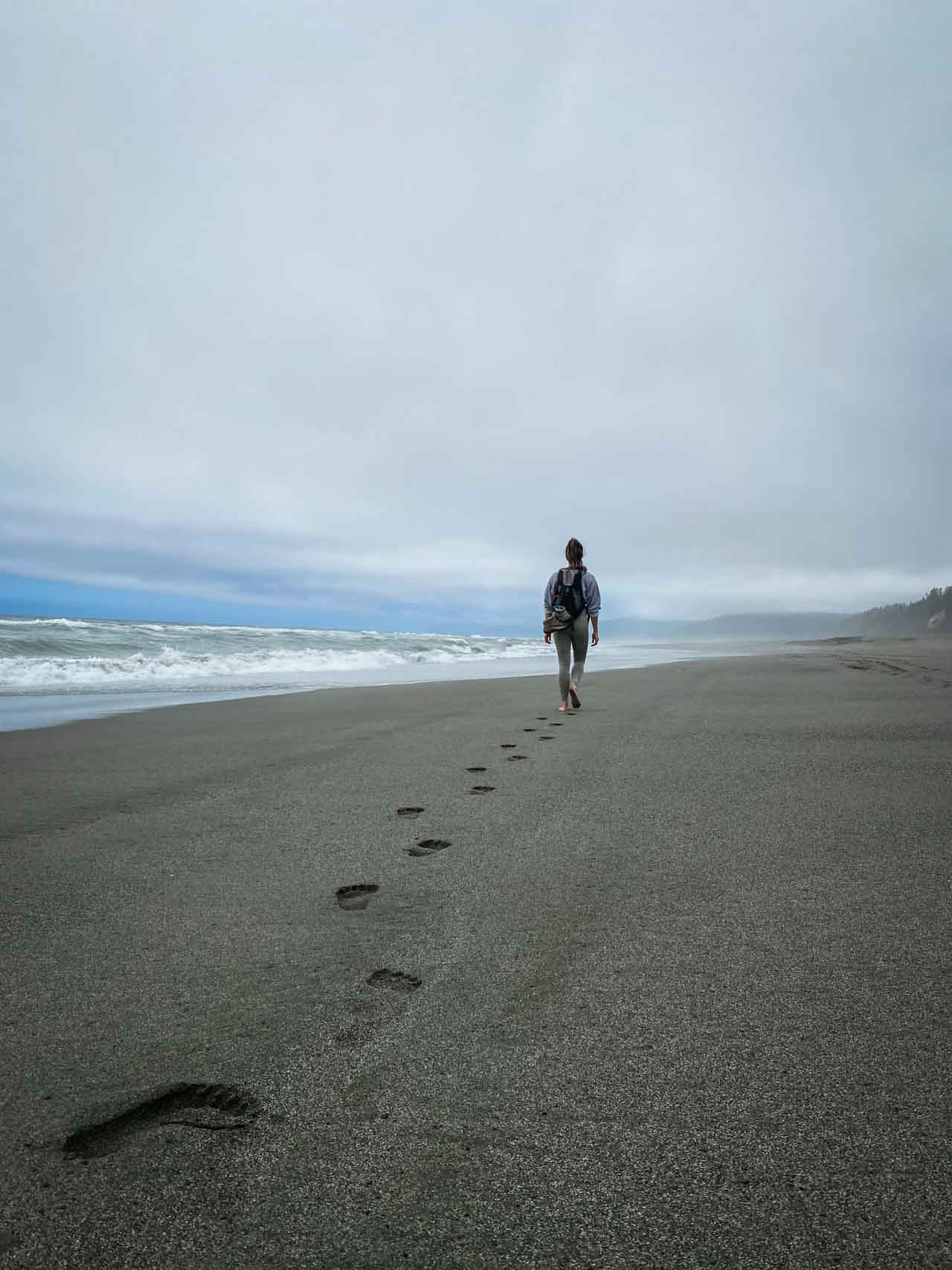
Following the rugged coastline in Redwood National and State Parks for 70 miles, the Coastal Trail is one of the greatest multi-day hikes in America’s national parks. It runs from Crescent Beach to Elk Meadow.
While backpacking its entire length is certainly possible for avid hikers, most visitors opt to do a section of this scenic trail. Especially the Gold Bluffs Beach section is popular, thanks to its beautiful coastal scenery and nearby attractions like Fern Canyon.
Along the way, you can explore tidepools, walk across gorgeous sandy beaches and underneath redwood-topped cliffs. There’s plenty of wildlife around, too, from starfish, crabs and sea lions to Roosevelt elk and black bears.
10. Visit Lady Bird Johnson Grove
Location: Redwood National Park
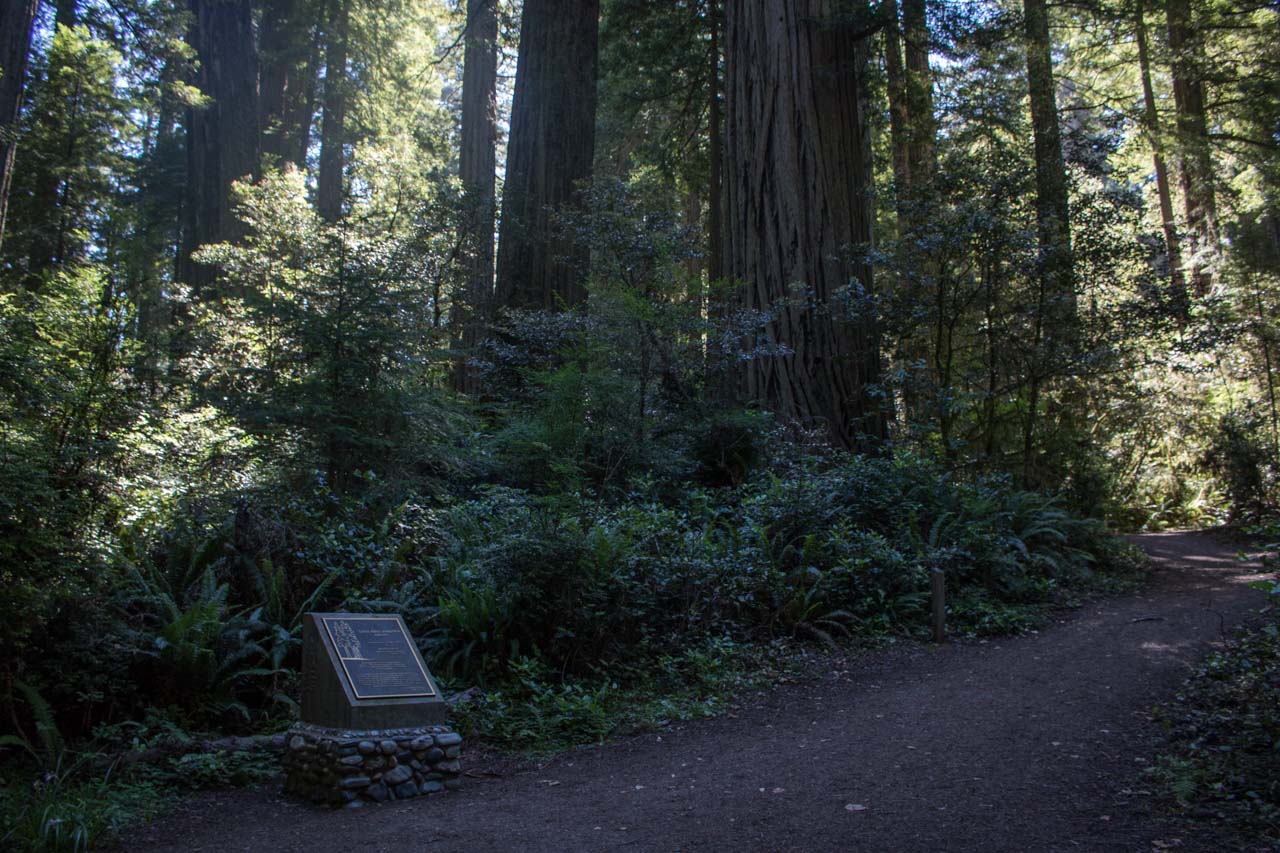
If you’re looking for short Redwood National Park trails, it doesn’t get any better than the Lady Bird Johnson Grove Trail. This pleasant 1.5-mile loop trail meanders through an upland stand of old-growth redwoods.
It runs past the site where Lady Bird Johnson—who actively fought for the protection and creation of natural habitats during her time as First Lady—dedicated Redwood National Park in 1968. A plaque commemorates that important day and location.
In addition to massive redwoods, this forest also consists of tanoak and Douglas fir, as well as azaleas and rhododendrons that add some beautiful color to the scenery in spring.
11. Drive the Bald Hills Road
Location: Redwood National Park
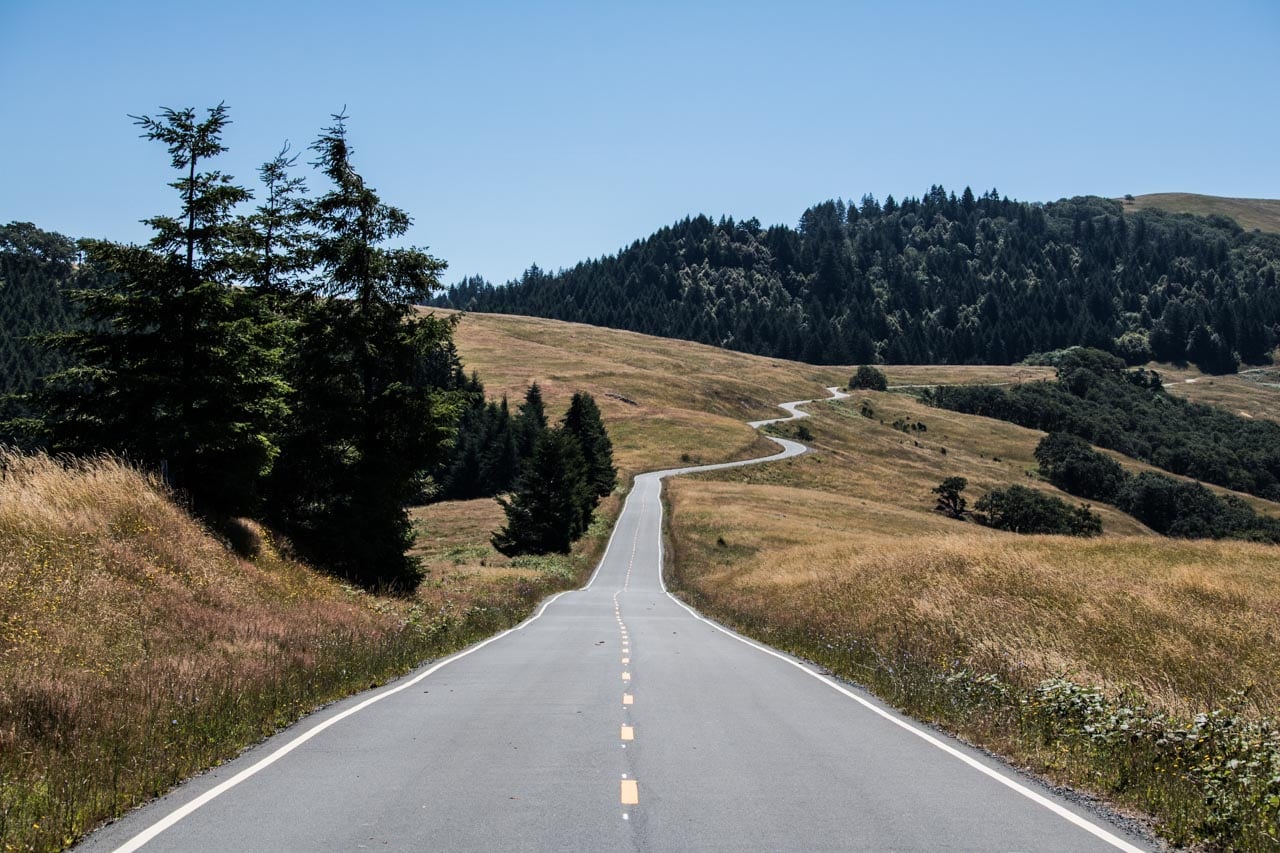
The scenic Bald Hills Road is off of U.S. 101 about 1 mile north of Orick. It’s the only road through Redwood National Park and offers access to both Lady Bird Johnson Grove and Tall Trees Grove.
Along its 17-mile course, the road climbs steeply (15 percent) from near sea level to the top of a series of coastal hills. It winds through a forest of huge old-growth redwoods and across several open prairies, which are home to Roosevelt elk and black bears.
In spring, this is a great place to enjoy an abundance of colorful wildflowers.
The first 13 miles of the Bald Hills Road are paved, the last section is gravel. Because of its steepness and sharp turns, large RVs and trailers are not recommended on this road.
12. Gaze Up at Huge Redwoods in Tall Trees Grove
Location: Redwood National Park
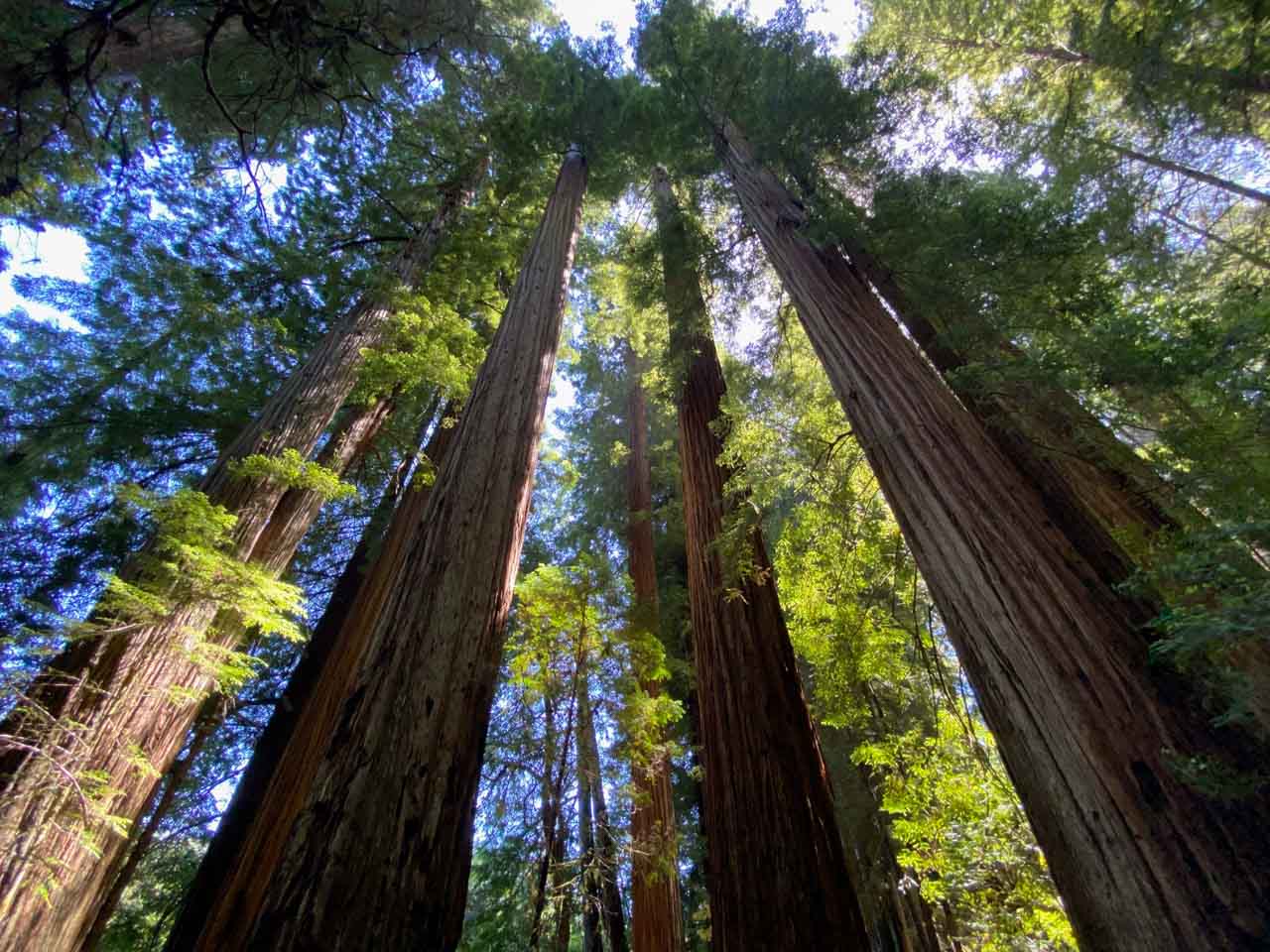
Made famous by a National Geographic Magazine article in 1963, the Tall Trees Grove played a vital role in the establishment of Redwood National Park several years later.
Thanks to its sheltered location, abundant water sources and fertile soil, the grove has many redwoods that are higher than 350 feet (106 meters). The tallest tree on Earth—Hyperion—is, however, not located here. Its location is kept secret to protect it.
Situated in the very heart of the national park, the Tall Trees Trail is one of the most popular places to visit in Redwood National Park. Getting there is not easy, though, and requires some planning.
First, you need to get a free permit, which is issued on a first-come first-served basis and contains a code to open the locked gate on the access road. It’s at least a 1-hour drive from the nearest visitor center to the trailhead, including about 6.5 miles on a steep, unpaved forest road.
Even though the Tall Trees Trail is only 4 miles in total, the whole trip, including the drive, takes about four hours.
Where to Stay Near Redwood National Park?
Several towns are scattered around this four-park complex, most of which have accommodations. So, if you’re not planning to camp, you can find motels, hotels, cabins and/or B&Bs in places like Eureka, Orick and Crescent City.
That being said, however, I always recommend spending at least one night in any national park you visit. The same, of course, applies to Redwood National and State Park. Each of the four parks has its own campground, all of which are developed and offer most basic campground facilities.
If you’d like to camp among huge redwoods, consider setting up camp at Jedediah Smith Campground or Mill Creek Campground. The Elk Prairie Campground, on the other hand, is a fantastic base camp for wildlife viewing at dawn and dusk.
The fourth campground—and by far my favorite—is Gold Bluffs Beach Campground. Located about 6 miles up unpaved Davison Road, this small 26-site campground sits on a remote sand beach, backed by cliffs and a redwood forest.
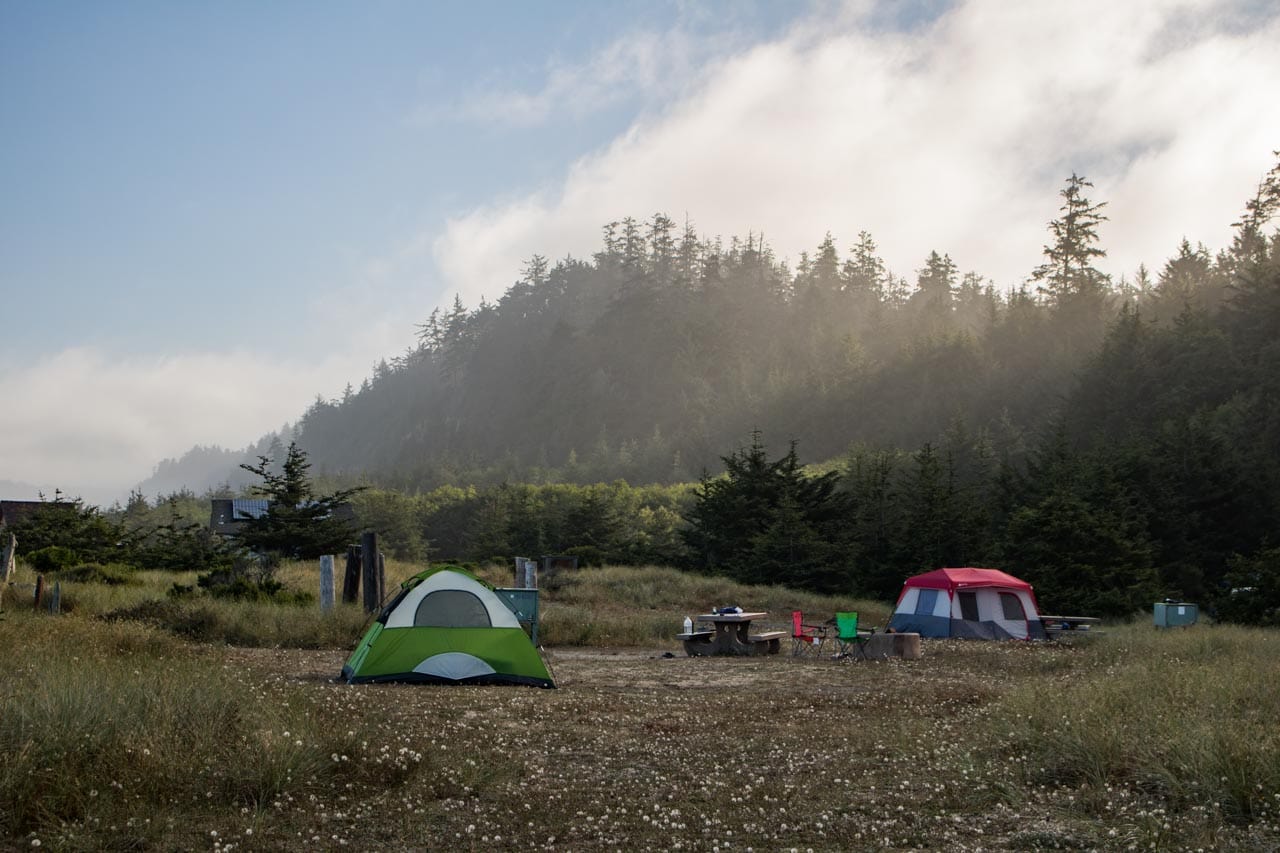
I loved this particular campground so much that I included staying there in my list of the best things to do in Redwood National Park and State Parks above. I could not recommend this place more.
Redwood Attractions Map
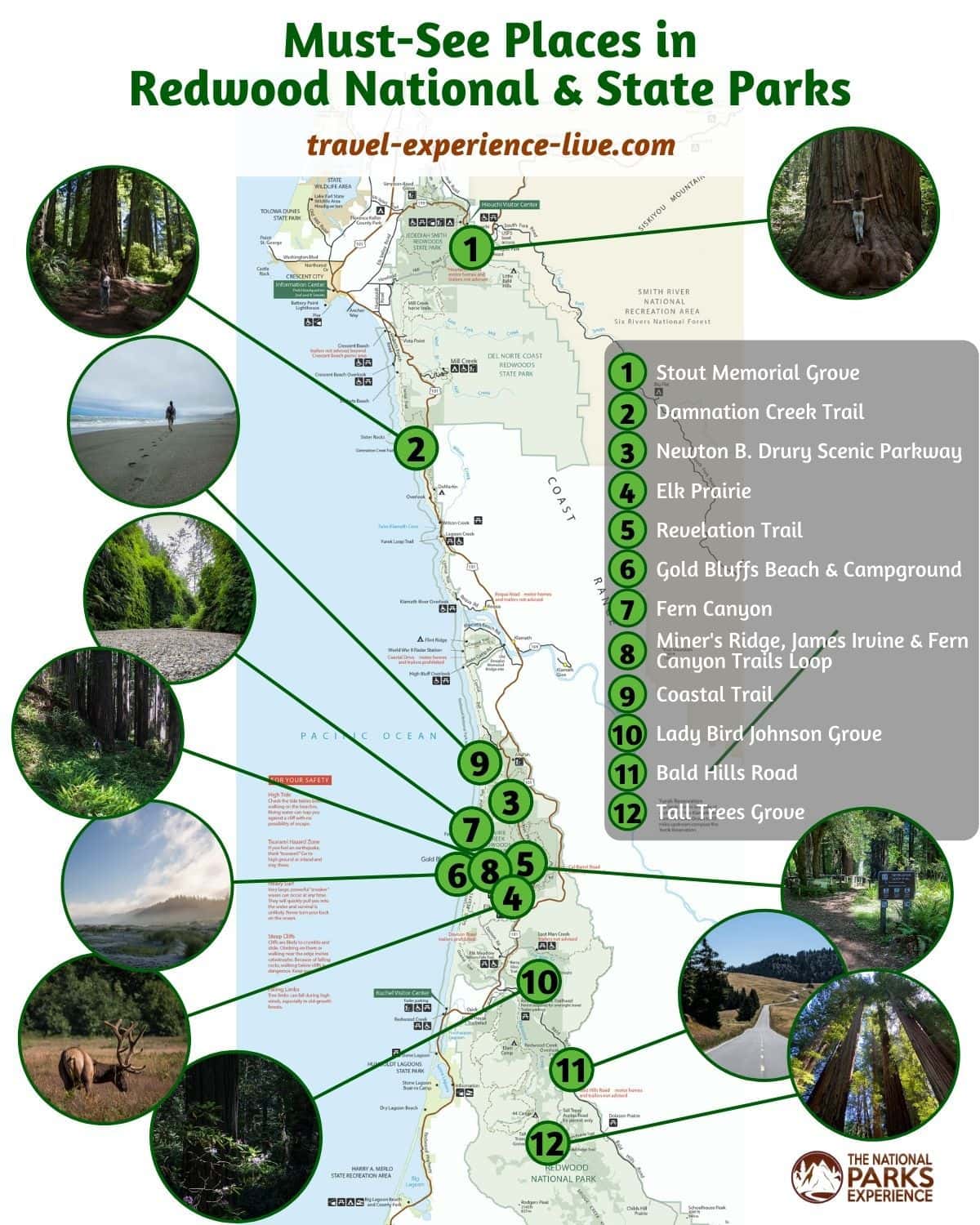
Suggested Itineraries for Redwood National and State Parks
Traversed by U.S. 101, one of America’s greatest highways, the Redwood National and State Parks complex can be a passing-through destination for some visitors, while others might want to spend a few days exploring these mighty forests and secluded coasts.
Whatever your itinerary dictates, there is a way to immerse yourself in the redwood forest.
1 Day in Redwood National and State Parks
Even if you only have one day in the Redwood parks, you can still make the most of your experience by focusing on the following activities and attractions. It also means that you won’t be able to visit all four parks, though.
- Drive the Newton B. Drury Scenic Parkway and do some short hikes
- See Roosevelt elk at Elk Prairie
- Drive Davison Road and enjoy Gold Bluffs Beach
- Walk through Fern Canyon
- Visit Lady Bird Johnson Grove
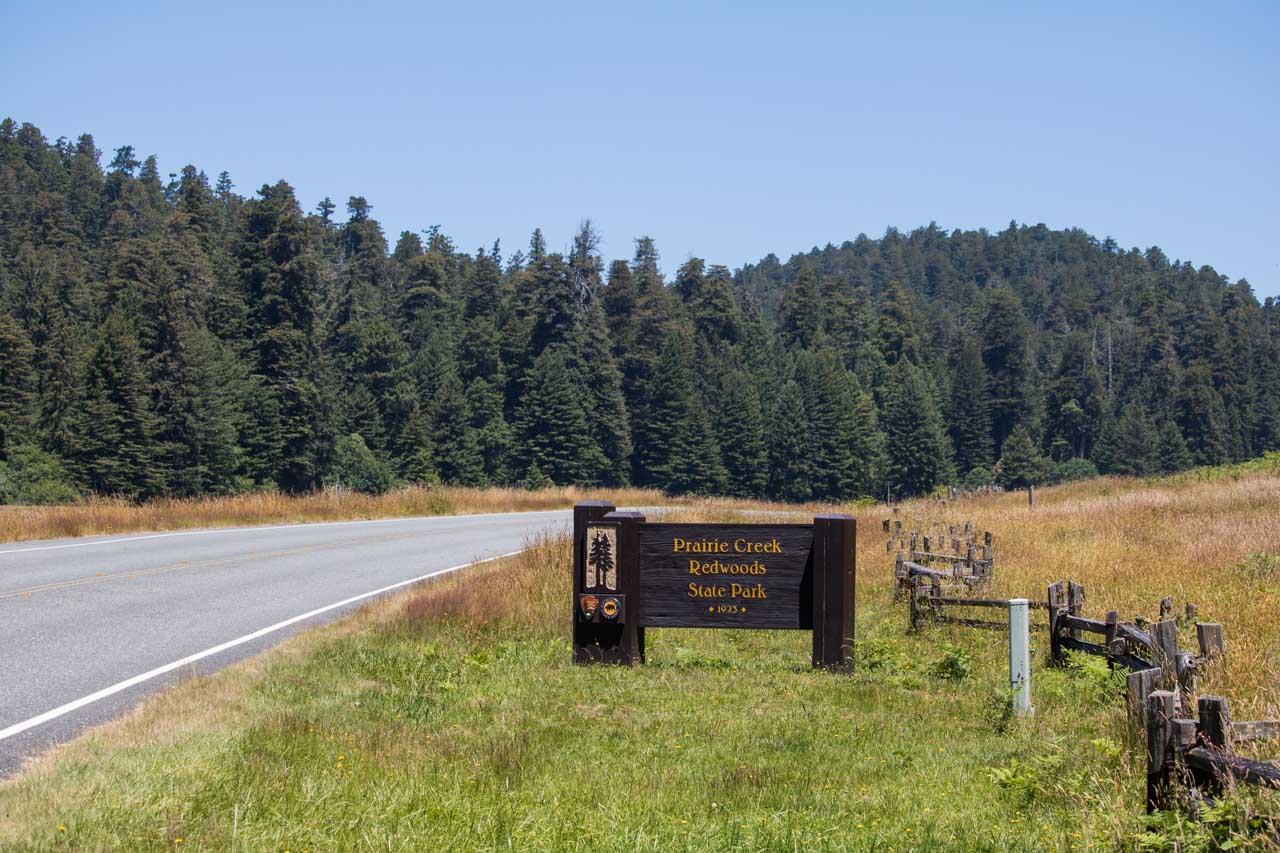
2 Days in Redwood National and State Parks
Spending two days in Redwood National and State Parks allows you to explore the parks complex in more detail.
Day 1 (Jedediah Smith Redwoods State Park, Del Norte Coast Redwoods State Park and Prairie Creek Redwoods State Park):
- Explore the Stout Memorial Grove
- Hike the Damnation Creek Trail
- Drive the Newton B. Drury Scenic Parkway
- See Roosevelt elk at Elk Prairie
- Camp at Gold Bluffs Beach
Day 2 (Prairie Creek Redwoods State Park and Redwood National Park):
- Walk through Fern Canyon
- Visit Lady Bird Johnson Grove
- Drive the Bald Hills Road
- Hike through Tall Trees Grove
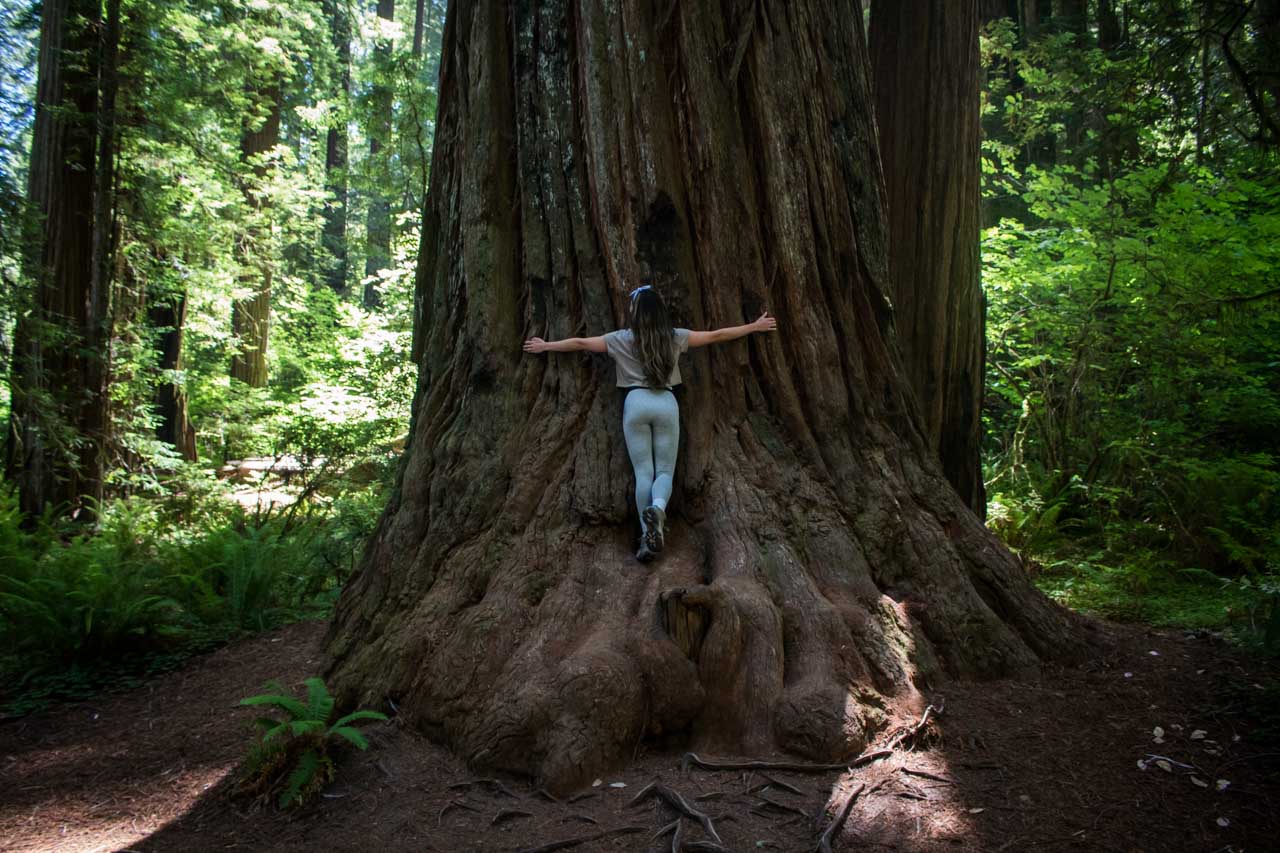
3 Days in Redwood National and State Parks (Recommended!)
While the two-day itinerary above is pretty solid, adding a third day to your Redwood National Park itinerary means that you can do all the activities mentioned above in this blog post.
We spent three full days in these parks, allowing us to visit both Redwood National Park and all three Redwood state parks. This suggested three-day itinerary for Redwood National Park is based on our time spent there.
Day 1 (Jedediah Smith Redwoods State Park, Del Norte Coast Redwoods State Park and Prairie Creek Redwoods State Park):
- Explore the Stout Memorial Grove
- Hike the Damnation Creek Trail
- Drive the Newton B. Drury Scenic Parkway
- See Roosevelt elk at Elk Prairie
- Camp at Gold Bluffs Beach
Day 2 (Prairie Creek Redwoods State Park):
- Hike the Miner’s Ridge – James Irvine Loop, which includes Fern Canyon and a section of the Coastal Trail
- Chill out at Gold Bluffs Beach
- Camp at Gold Bluffs Beach
Day 3 (Redwood National Park):
- Visit Lady Bird Johnson Grove
- Drive the Bald Hills Road
- Hike through Tall Trees Grove
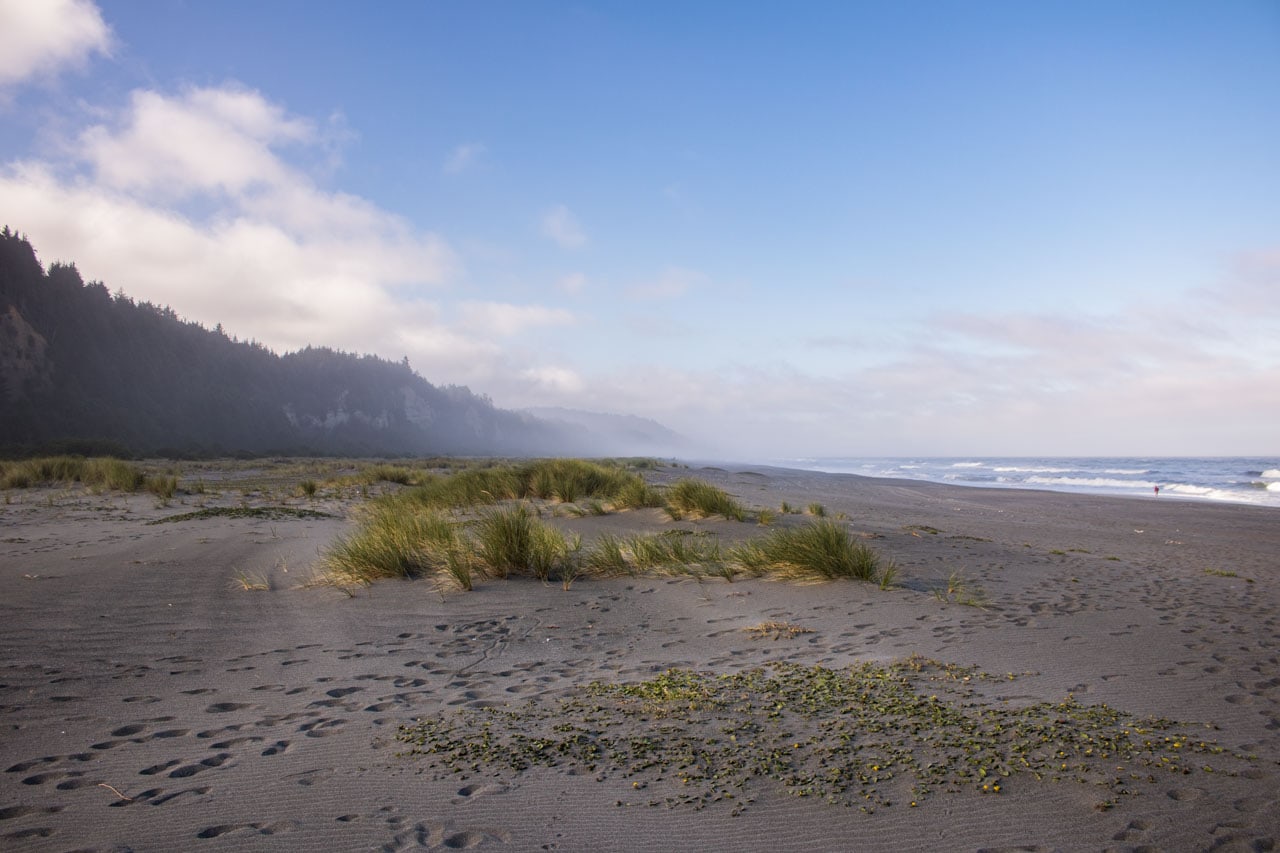
Redwood National Park Video
After decades of logging in the 19th and early-20th centuries, the massive redwoods were on the brink of extinction. California state parks were established to save some of the last remaining redwood groves, followed by the creation of Redwood National Park in the fall of 1968.
Nowadays, a number of organizations and conservationists continue to fight for the redwoods in northern California. One of the organizations I’d like to highlight is the Save the Redwoods League, a nonprofit that has been pushing for redwood preservation since 1918.
In the video below, they’ve partnered up with Teresa Baker, a Bay Area-based advocate for more diversity in the outdoors. It’s a great 10-minute video that shows the importance of more inclusion of minorities in America’s parks.
Other Nearby National Parks to Explore
The Redwood National and State Parks are a phenomenal Pacific Northwest park to visit. But what makes this even more attractive is the fact that there are several more epic parks in the region.
From massive volcanoes and an impossibly blue lake to razor-sharp mountain peaks and pristine temperate rain foresst, I recommend that you at least consider visiting one of these other national parks in the Pacific Northwest:
- Lassen Volcanic National Park, California
- Crater Lake National Park, Oregon
- Mount Rainier National Park, Washington
- Olympic National Park, Washington
- North Cascades National Park, Washington


